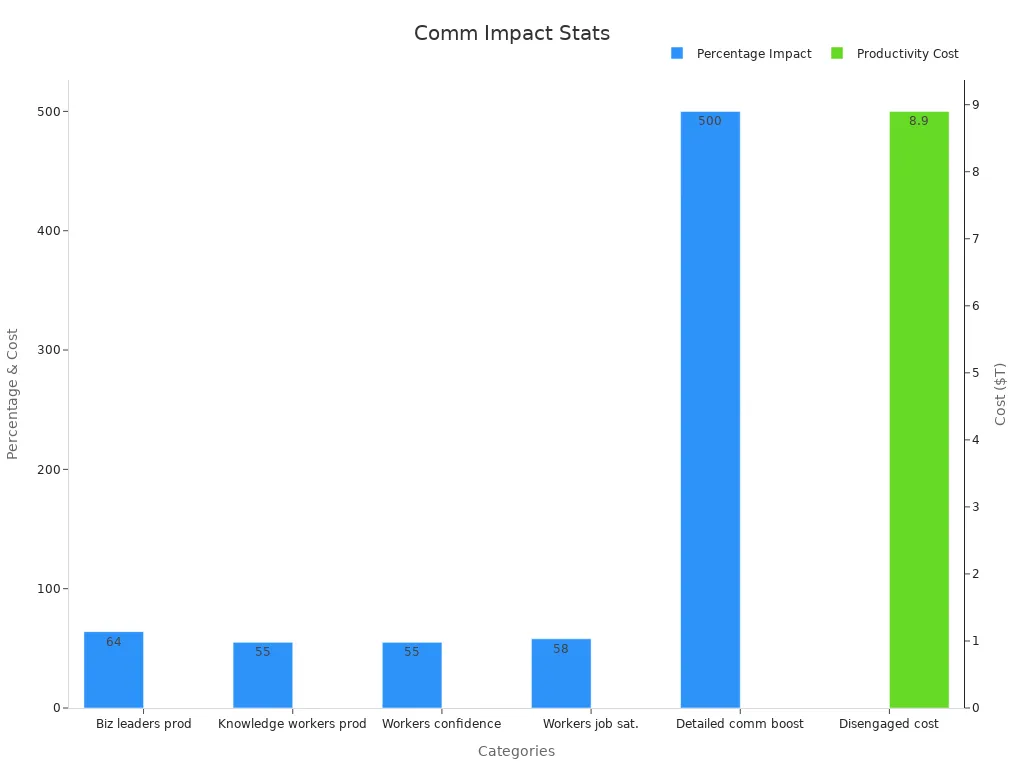Why Does Writing a Paragraph Help Improve Clarity in Communication? Why Does Writing a Paragraph Help Improve Clarity in Communication?

Clear communication starts by organizing your thoughts. Writing a paragraph helps you arrange ideas in order, making them clear. Each paragraph is like a building block, keeping your message focused. When ideas are organized, you avoid confusion and explain better. Whether sharing a story or explaining something, this skill helps others understand you.
Good communication is important in all parts of life. Writing a paragraph is an easy way to make ideas clear and connect with people.
Key Takeaways
Writing a paragraph helps organize ideas and makes messages clear.
Clear communication uses easy words and a simple structure.
Good communication boosts confidence and helps you work better.
Each paragraph should have one idea to prevent confusion.
Topic sentences help readers understand and keep writing neat.
Supporting sentences give details to explain the main idea.
Editing and revising make writing clearer and fix errors.
Writing every day improves your communication skills over time.
Understanding Clarity in Communication
What Is Clarity in Communication?
Clarity in communication means sharing ideas in a simple way. It uses easy words, organizes thoughts, and avoids being too complicated. When you are clear, people understand your message without confusion.
Writing clearly is important for all writers. It helps share ideas exactly and avoids misunderstandings, saving everyone’s time.
In school or work, clear writing often needs structure. For example, academic writing uses rules to stay neat and trustworthy. This makes hard ideas easier to read and understand. Clear communication is not just about words; it’s about how you show your ideas.
Why Is Clarity Important in Everyday Interactions?
Clear communication is key in daily life. It helps you share ideas, make friends, and fix problems. Whether talking to someone, writing a note, or giving a speech, being clear helps others understand you.
Studies say good communication boosts confidence and work success. For example, 64% of leaders think clear communication helps people work better. Also, 55% of workers feel more confident when communication is clear. Workers included in detailed talks are five times more productive.
Statistic Description | Percentage |
|---|---|
Leaders who think clear communication improves work | 64% |
Workers who say clear communication helps them work better | 55% |
Workers who feel confident with clear communication | 55% |
Workers who feel happier with clear communication | 58% |
Workers included in detailed talks are more productive | 500% (5 times) |
Lost productivity cost from unclear communication | $8.9 trillion |

Clear communication also builds better relationships. It lowers mistakes and builds trust. When you are clear, you respect others’ time and attention.
Common Barriers to Clear Communication
Many things can make communication unclear. These include language problems, cultural differences, and hard-to-understand words. Disabilities, low reading skills, and lack of time also make it harder.
Hard medical terms
Language problems
Cultural misunderstandings
Disabilities and other issues
Low reading skills
Complicated topics
Not enough time
To fix these problems, use simple words and adjust your message. Don’t give too much information at once. Instead, break it into smaller, easier parts. This makes your message clearer and simpler to understand.
The Role of Writing a Paragraph in Clear Communication

How Paragraphs Organize Thoughts
Writing paragraphs helps arrange your ideas clearly. Each paragraph focuses on one idea, making it easier to understand. Before writing, you can plan by creating an idea map. This step helps organize your thoughts before starting.
A good paragraph has unity, coherence, and development. Unity means sticking to one topic. Coherence puts sentences in order and connects them with linking words. Development adds details like facts or examples to explain the idea. These parts work together to make your message clear and organized.
Description | |
|---|---|
Unity | Keeps the paragraph focused on one main idea. |
Coherence | Links sentences in order using pronouns or transition words. |
Development | Adds facts, examples, or details to explain the idea. |
Relevance | Makes sure the paragraph connects to the main topic. |
Pre-Writing | Helps plan ideas by mapping them out before writing. |
By using these elements, your writing becomes clearer and easier to follow.
Enhancing Logical Flow Through Paragraphs
Paragraphs help ideas flow in a logical way. When ideas connect smoothly, readers stay interested and understand better. Coherence makes sure each sentence naturally leads to the next. This creates easy-to-read writing.
Using phrases like "for example" or "in addition" connects ideas. These words guide readers and show how points build on each other. Logical flow keeps readers engaged and helps explain your ideas clearly.
Coherence links sentences, making ideas flow smoothly for readers.
Transition words connect paragraphs, showing how ideas relate to each other.
Logical flow keeps readers interested and makes writing easier to understand.
Focusing on logical flow makes your writing clearer and more convincing.
Reducing Misunderstandings with Structured Writing
Organized paragraphs help avoid misunderstandings. Each paragraph explains one idea, making your message clear. This helps readers know exactly what you mean.
A clear structure shows how your ideas fit together. Readers can see the connections, which makes your argument stronger. Structured paragraphs also save time by being concise. You can share your message in fewer words, helping both you and your audience.
Organized writing makes each paragraph focus on one clear idea.
A clear structure shows how ideas connect, making arguments stronger.
Concise writing reduces confusion and saves time for everyone.
Writing structured paragraphs ensures your message is clear and easy to understand.
Key Elements of Writing a Clear Paragraph
Why a Good Topic Sentence Matters
A good topic sentence is the base of a clear paragraph. It tells the main idea and gives readers a hint of what’s coming. Think of it as a signpost that guides your writing. Without it, your paragraph might seem messy or unclear.
A topic sentence should do three things: share the main idea, link to the bigger argument, and guide the reader. For example:
It states the main idea of the paragraph.
It shows how the paragraph fits into the bigger topic.
It helps readers focus on the key point.
Paragraph Level | |
|---|---|
Thesis statement | Topic sentence |
Body paragraphs | Supporting details, explanation |
Conclusion | Wrap-up sentence(s) |
Writing a clear topic sentence keeps your paragraph focused. This makes it easier for readers to understand your message.
Adding Value with Supporting Sentences
Supporting sentences are the heart of your paragraph. They give examples, facts, or proof to back up the topic sentence. Think of a paragraph like a sandwich: the topic sentence is the top bread, the supporting sentences are the filling, and the concluding sentence is the bottom bread. Without the "filling," the paragraph feels empty.
These sentences explain the main idea and add details to your writing. For example, if your topic sentence talks about exercise benefits, your supporting sentences could include facts, examples, or health tips. This setup keeps your paragraph clear and flows smoothly from one idea to the next.
When writing, make sure your supporting sentences are specific and helpful. Don’t add extra details that confuse the reader. Focus on making the main idea stronger with useful information.
Wrapping Up with Concluding Sentences
A concluding sentence finishes your paragraph and reminds readers of the main idea. It gives closure and helps readers remember the key point. A good concluding sentence doesn’t just repeat the topic sentence. Instead, it sums up the paragraph in a new way or adds a fresh thought.
For example, if your paragraph is about hybrid cars, the concluding sentence could mention their low costs and eco-friendly benefits. This leaves a strong impression and ties the paragraph together.
A concluding sentence sums up the main idea in new words.
It highlights the key message, helping readers understand the purpose.
It gives closure, making your writing feel complete.
Adding a strong concluding sentence improves clarity and impact. This small step ensures your message sticks with your audience.
Benefits of Writing a Paragraph for Communication Clarity
Clearer Thinking and Better Expression
Writing a paragraph helps you think clearly and share ideas better. Focusing on one idea per paragraph keeps your thoughts organized. This method avoids unclear ideas and makes your points stronger and easier to understand.
Clear and organized writing avoids confusion and improves communication skills.
To do this, make sure your paragraph includes:
Unity: Focus on one main idea only.
Coherence: Put sentences in a logical order.
Development: Add facts, examples, or reasons to explain your idea.
Following these steps creates clear and meaningful paragraphs. This practice also helps you think critically and express yourself more effectively.
Easier Reading and More Interest
Good paragraphs make your writing simple to read and interesting. Breaking information into smaller parts helps readers understand it better. Adding subheadings and bullet points makes your writing even clearer.
For example:
Using simple words helps readers understand faster.
Bullet points highlight important ideas quickly.
Subheadings guide readers through the content easily.
Clear paragraphs show respect for your reader’s time and focus. This keeps them interested and ensures they understand your message. Writing this way improves clarity and makes your content enjoyable to read.
Better Understanding and Memory
Clear paragraphs help readers understand and remember your ideas. When sentences connect smoothly, your message is easier to follow. Words like "for example" or "in conclusion" help guide readers through your writing.
Breaking content into small sections also helps memory. Keeping each paragraph focused on 2-3 points makes it easier to remember. Using tools like bullet points or pictures helps different types of learners understand better.
Clear paragraphs connect ideas, making them easier to follow.
Transition words guide readers and improve understanding.
Focused writing helps readers remember key points.
By organizing your paragraphs well, you help readers understand and remember your message.
Actionable Tips for Writing a Paragraph Effectively
Begin with a Clear Topic Sentence
A good paragraph starts with a clear topic sentence. This sentence tells the main idea and sets the tone. It helps you stay focused and shows readers what to expect. A strong topic sentence keeps the paragraph organized and easy to follow.
To write a strong topic sentence, focus on one main idea. Avoid being too general or unclear. For example, instead of saying, "Exercise is good," write, "Regular exercise helps reduce stress and improves mood." This makes your paragraph more specific and interesting.
Tip: A topic sentence should connect to the main purpose of your writing. It should make a point that the rest of the paragraph explains and supports.
Stay Focused and Avoid Unrelated Details
Staying focused is important for writing a clear paragraph. Every sentence should support the main idea in the topic sentence. Adding unrelated details can confuse readers and weaken your message. Keeping your paragraph focused makes it easier to understand.
Before writing, plan your paragraph carefully. Think about the main idea and the points you want to include. Avoid adding extra words or ideas that don’t fit. For example, if your paragraph is about reading benefits, don’t start talking about writing tips.
Tip: Read your paragraph as if you were someone else. Check if every sentence supports the main idea. If something doesn’t fit, change it to make it clearer.
Use Simple and Clear Language
Simple language makes your writing easier to read. Readers understand better when you avoid long or hard-to-read words. Short and clear sentences keep your audience interested and make your message stronger.
Pick words that are easy to understand and avoid repeating yourself. For example, instead of saying, "Due to the fact that," just say, "Because." This saves space and makes your writing clearer. Don’t use technical words unless needed, and explain them if you do.
Tip: Break big ideas into smaller parts. This helps readers understand better and makes your writing clearer.
By using these tips, you can write better paragraphs. Clear topic sentences, focused content, and simple words make your writing easy and enjoyable to read.
Revise and Edit for Maximum Clarity
Fixing and improving your paragraphs is key for clear writing. These steps help you improve ideas, fix errors, and make your message easy to follow. Skipping this step can make your writing unclear or full of mistakes, which might confuse readers.
When revising, you work on making your paragraphs better organized. This step helps you find weak spots and improve them. For example, you might see that a paragraph is off-topic or sentences don’t flow well. By fixing and rewriting, you can make your ideas clearer and stronger.
Editing focuses on small details like grammar, spelling, and punctuation. Even tiny mistakes can change the meaning of a sentence or make it harder to read. For example, a wrong comma can confuse readers or change your tone. Careful editing makes your writing neat and professional.
Tip: Read your paragraph out loud. This helps you notice awkward sentences or unclear ideas you might miss when reading silently.
Here’s why revising and editing are important:
Editing shows you care about details, which builds trust with readers.
Revising helps fix weak parts, making your writing flow better.
Editing corrects grammar and punctuation, making your message clearer.
Keeping each paragraph focused on one idea makes your writing stronger.
To revise well, check if each paragraph has a clear topic sentence. Make sure all other sentences support the main idea. If a sentence doesn’t fit, move or rewrite it. Also, check how sentences connect. Words like "but" or "for instance" can guide readers through your ideas.
When editing, check grammar and word choice carefully. Don’t use hard-to-understand words or phrases. Simple words often work better. Also, avoid repeating the same words or ideas. Repetition can make your writing boring and less clear.
Note: Revising and editing take time, but they are worth it. Clear and polished writing leaves a strong impression on readers.
By revising and editing well, your paragraphs will be clear, focused, and effective. This process not only improves your writing but also helps you share your ideas better.
Practicing Writing a Paragraph to Improve Communication Skills

Adding Daily Writing Practice
Writing every day can improve how you communicate. It helps you organize ideas and share them clearly. Start by writing one short paragraph daily about something you like. This habit builds confidence and makes sharing ideas easier.
Here are ways to make daily writing more helpful:
Write so a 5th grader can understand. This keeps it clear.
Use real-life examples to make your writing interesting.
Set a goal, like explaining or convincing, for each practice.
Research shows daily writing has real benefits. Programs like NoRedInk and ThinkCERCA improve writing and reading skills.
Program | Benefits | Evidence Level |
|---|---|---|
NoRedInk | Boosts test scores; uses lessons based on interests | Research-based |
ThinkCERCA | Improves reading by 2+ years; 20% better writing; personal skill growth | Meets ESSA levels |
Writing daily not only improves skills but also deepens your understanding of topics.
Learning from Good Paragraph Examples
Looking at well-written paragraphs can teach you how to write better. A strong paragraph sticks to one idea, flows smoothly, and connects sentences well. Words like "for example" or "because" help link ideas clearly.
Here’s what to notice in good paragraphs:
Coherence makes ideas flow naturally.
Logical order keeps readers interested.
Facts or examples make arguments stronger.
For instance, a paragraph on climate change might start with its effects. Supporting sentences could include temperature data and expert quotes. The last sentence might stress the need for action. Studying examples like this helps you write more clearly and effectively.
Using Feedback to Improve Writing
Feedback helps you make your writing better. Others can spot unclear parts or suggest improvements. Different opinions can show you things you missed.
Here’s how to use feedback well:
Ask friends or coworkers to review your writing.
Use their advice to fix weak areas.
Check writing guides for extra tips.
For example, if someone says your paragraph is unclear, add linking words or rearrange sentences. This process improves your current work and builds better habits.
Tip: See feedback as a chance to grow. Every suggestion helps you improve.
By practicing daily, studying examples, and using feedback, you can get better at writing paragraphs. These steps will boost your communication skills and make your writing stronger.
Writing a paragraph is a great way to improve communication. It helps you arrange your thoughts in a clear order. This makes your ideas flow smoothly and easier to understand. Practicing often can make your communication skills stronger. You will express yourself better and more clearly. Whether talking with friends or at work, this skill helps you share ideas confidently. Start practicing now to see how it improves your connections with others.
FAQ
Why do we write paragraphs?
Writing paragraphs helps you sort your ideas. It lets you focus on one thought at a time, making your message simple and clear. This skill is useful for both personal and work communication.
How does writing make communication better?
Writing helps you explain ideas clearly. It teaches you to organize thoughts, use clear words, and avoid confusion. Practicing often makes your communication skills stronger.
Why is a topic sentence important?
A topic sentence tells the main idea of the paragraph. It guides the reader and shows what the paragraph is about. Without it, your writing might seem messy or unclear.
How can you make paragraphs more interesting?
Use easy words and add examples or facts to explain your ideas. Break big ideas into smaller parts. Words like "for example" or "also" help your writing flow better.
What mistakes should you avoid in paragraphs?
Don’t add unrelated details or use hard-to-read words. Always revise and edit your work. Skipping these steps can make your writing unclear or confusing.
How often should you practice writing?
Try writing every day. Writing one short paragraph daily builds confidence and improves your skills. Pick different topics to keep it fun and challenging.
Can writing paragraphs help at work?
Yes, writing clear paragraphs is very helpful at work. It helps you share ideas clearly, avoid mistakes, and earn trust. Clear writing shows you are professional and careful.
What tools can help with writing?
Use tools like Grammarly or Hemingway Editor to check your work. Reading good examples of paragraphs can give you ideas. Feedback from others also helps you improve.

